Did you know that indoor plants can reduce stress levels by up to 40% according to studies by the University of Technology Sydney? While you’re likely familiar with basic houseplants, there’s an entire world of unique specimens that can transform your living spaces into vibrant, air-purifying sanctuaries. From low-light champions that thrive in dark corners to statement pieces that command attention, these nine carefully selected plant varieties will help you create a personalized indoor garden that matches both your lifestyle and design preferences.
Contents
- 1 Low-Light Champions: Plants That Thrive in Dark Corners
- 2 Statement Plants for Dramatic Impact
- 3 Air-Purifying Powerhouses
- 4 Pet-Friendly Indoor Plant Options
- 5 Small Space Solutions: Compact Plants for Tight Spots
- 6 Hanging Plants to Create Vertical Interest
- 7 Easy-Care Succulents and Cacti
- 8 Tropical Plants for Bathroom Bliss
- 9 Colorful Foliage Plants Beyond Basic Green
Low-Light Champions: Plants That Thrive in Dark Corners

Low-light plants are nature’s adaptable survivors, evolved to thrive in dim conditions that mimic their natural habitat beneath dense forest canopies. Popular varieties include the cast iron plant (Aspidistra elatior), snake plant (Sansevieria), ZZ plant (Zamioculcas zamiifolia), and Chinese evergreen (Aglaonema).
These plants typically feature deep green, glossy leaves that are efficient at photosynthesizing in minimal light, though some varieties showcase striking variegation patterns that add visual interest to dark corners.
Growing Conditions:
- Light: Tolerates low to moderate indirect light; avoid direct sunlight
- Water: Allow top 1-2 inches of soil to dry between waterings
- Soil: Well-draining potting mix with good aeration
- Humidity: Adaptable to average indoor humidity levels
- Temperature: Comfortable in typical room temperatures (60-75°F)
- Fertilizer: Light feeding every 2-3 months during growing season
Regular dusting of leaves with a damp cloth helps these plants maximize their light absorption capacity in dim conditions.
Watch for signs of overwatering, which is the most common issue with low-light plants, as reduced light means slower water uptake. Rotate the pot quarterly to ensure even growth, and trim any yellowing or dead foliage promptly to maintain plant health and appearance.
While these plants are generally slow-growing, this characteristic makes them relatively low-maintenance and forgiving of occasional neglect.
Statement Plants for Dramatic Impact
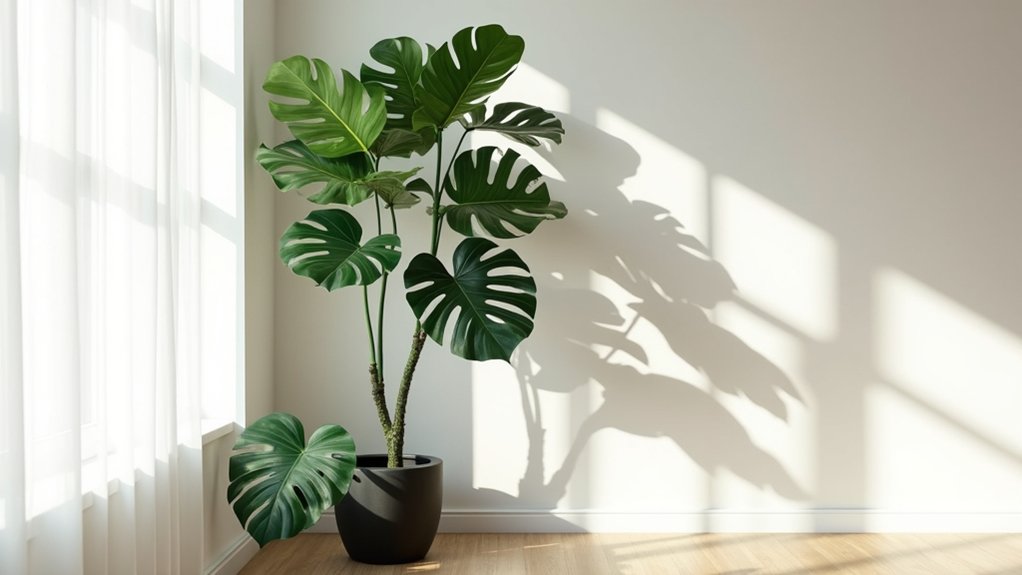
Statement plants are bold, attention-grabbing specimens that serve as living focal points in interior spaces. These dramatic indoor plants typically feature striking characteristics like towering height, unusual leaf patterns, vibrant colors, or architectural shapes. Popular examples include the Bird of Paradise with its large tropical leaves, Monstera deliciosa with its distinctive split foliage, and Fiddle Leaf Fig trees with their impressive stature and violin-shaped leaves.
- Light: Bright, indirect sunlight; avoid direct afternoon sun
- Water: Moderate watering when top 2-3 inches of soil feels dry
- Soil: Well-draining, nutrient-rich potting mix
- Humidity: 40-60% relative humidity
- Temperature: 65-80°F (18-27°C)
- Container: Large pots with adequate drainage holes
- Fertilizer: Monthly feeding during growing season
Regular maintenance of statement plants involves rotating them quarterly for even growth, dusting large leaves with a damp cloth to maintain their glossy appearance, and pruning damaged or yellowing foliage.
These plants benefit from occasional misting and proper spacing to ensure good air circulation. During winter, reduce watering frequency and pause fertilization to accommodate natural dormancy periods while maintaining consistent room temperatures away from cold drafts.
Air-Purifying Powerhouses
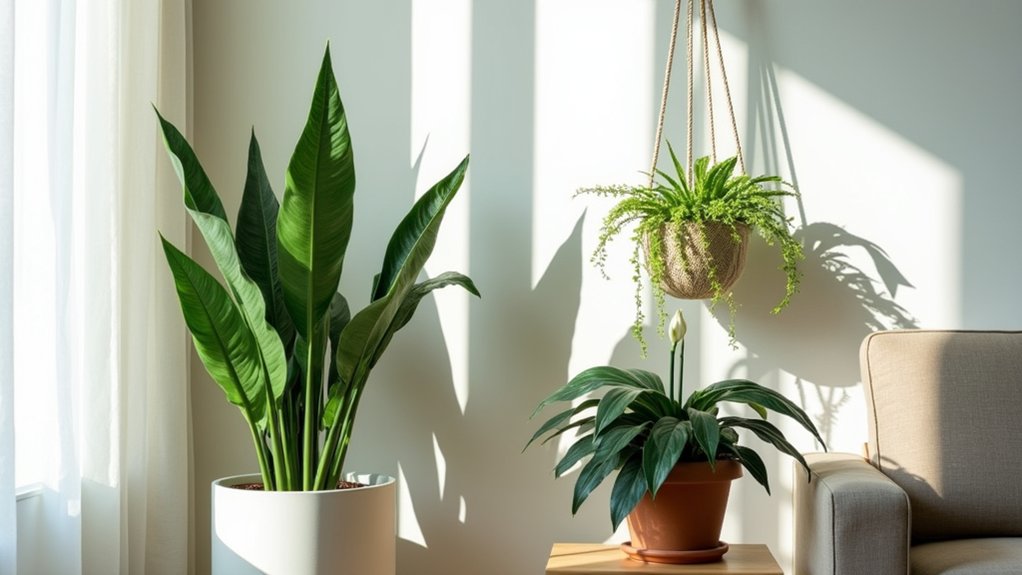
Air-purifying houseplants serve as natural filters, actively removing common indoor pollutants like formaldehyde, benzene, and carbon monoxide from the air. Popular varieties include the spider plant with its arching green and white striped leaves, the snake plant with tall, rigid, sword-like foliage, and the peace lily featuring glossy dark leaves and white blooms.
These plants not only clean the air but also add striking visual elements to any indoor space while increasing humidity and oxygen levels.
- Light Requirements: Most air-purifying plants thrive in indirect light; some varieties like snake plants tolerate low light conditions
- Water Needs: Moderate watering; allow top inch of soil to dry between waterings
- Soil Type: Well-draining potting mix with good aeration
- Temperature: 65-80°F (18-27°C)
- Humidity: Average household humidity (40-60%)
- Container: Pots with drainage holes to prevent root rot
Regular maintenance of air-purifying plants involves dusting leaves monthly to maximize their filtering capability, removing yellowed or dead foliage promptly, and rotating pots quarterly to ensure even growth.
Avoid placing these plants near air vents or drafty windows, as sudden temperature changes can stress them. Grouping multiple air-purifying plants together creates a more effective natural filtration system while also increasing local humidity levels through transpiration.
Pet-Friendly Indoor Plant Options
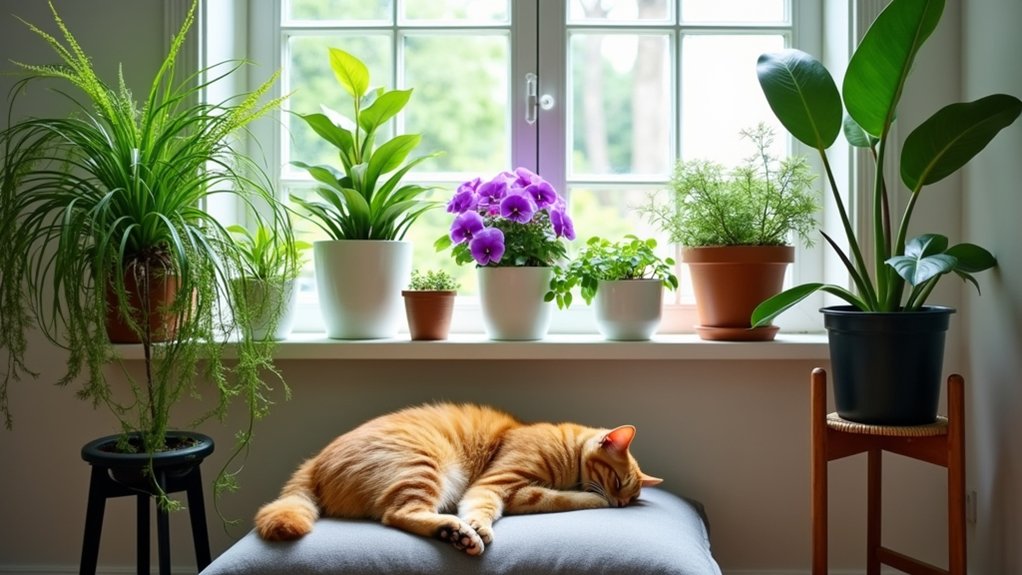
Pet-friendly indoor plants provide a safe way to add greenery to homes with cats and dogs, ensuring that any curious nibbling won’t result in toxic reactions. Popular non-toxic options include the Boston Fern with its lush, arching fronds; the African Violet with its compact size and colorful blooms; the Spider Plant with its grass-like cascading leaves; and the sturdy Cast Iron Plant with its broad, upright foliage.
These plants have been extensively tested and proven safe for households with pets while still offering attractive decorative appeal.
Growing Conditions:
- Moderate to bright indirect light, avoiding harsh direct sun
- Well-draining potting mix with good aeration
- Regular watering when top inch of soil feels dry
- Humidity levels between 40-60%
- Room temperatures between 65-75°F (18-24°C)
- Monthly feeding during growing season with balanced fertilizer
- Container with drainage holes to prevent root rot
Regular grooming keeps pet-friendly plants looking their best while preventing potential issues.
Remove any yellowed or damaged leaves promptly, rotate plants quarterly for even growth, and inspect regularly for pests that pets might bring in through contact.
Placing plants on elevated surfaces or hanging baskets can help minimize pet access while still maintaining visual appeal.
Consider grouping multiple pet-safe plants together to create a dedicated pet-friendly plant corner that’s both attractive and worry-free.
Small Space Solutions: Compact Plants for Tight Spots
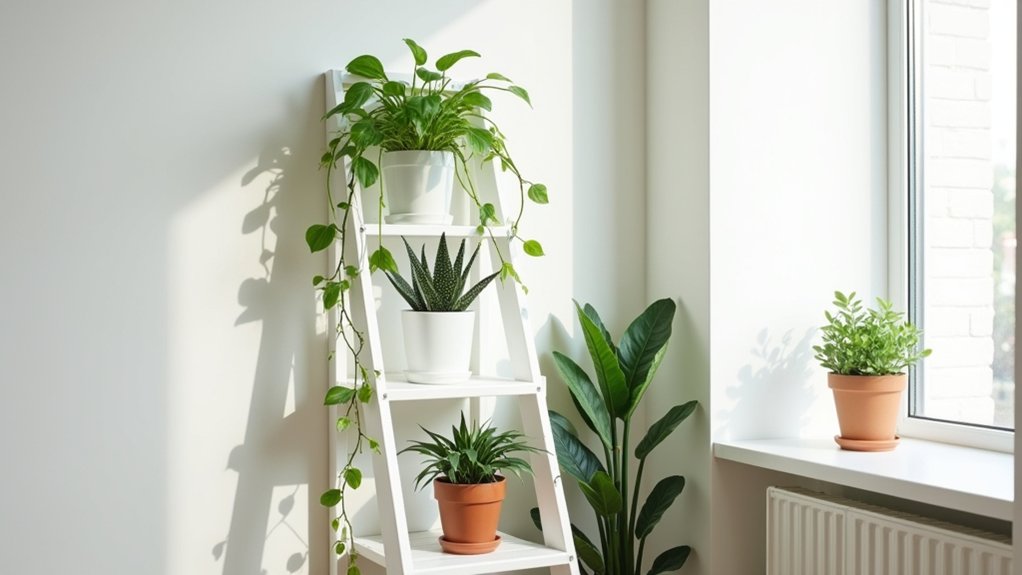
Small space solutions for indoor plants focus on compact varieties that maximize vertical space while minimizing their footprint. These space-saving plants include options like Chinese Evergreen, Snake Plant, ZZ Plant, and Pothos, which can thrive in tight corners, on narrow windowsills, or mounted on walls.
Many of these plants naturally stay small or can be easily maintained at a manageable size through proper pruning, making them perfect for apartments, small offices, or cramped room corners.
- Light requirements: Most compact plants tolerate low to moderate light; some varieties can adapt to fluorescent lighting
- Water needs: Generally require less frequent watering; allow top inch of soil to dry between waterings
- Soil preference: Well-draining potting mix with good aeration
- Temperature range: Comfortable room temperature between 65-80°F (18-27°C)
- Humidity: Average indoor humidity levels (40-60%)
- Container needs: Small to medium pots with drainage holes; consider self-watering containers for tight spaces
Regular grooming is essential for maintaining compact plants in small spaces.
Remove any yellowed or dead leaves promptly to prevent disease and maintain aesthetics. Rotate plants quarterly to ensure even growth, and trim back wandering stems to maintain desired shape.
Consider using vertical gardening techniques like wall-mounted planters or tiered stands to maximize available space while ensuring proper air circulation between plants.
Hanging Plants to Create Vertical Interest
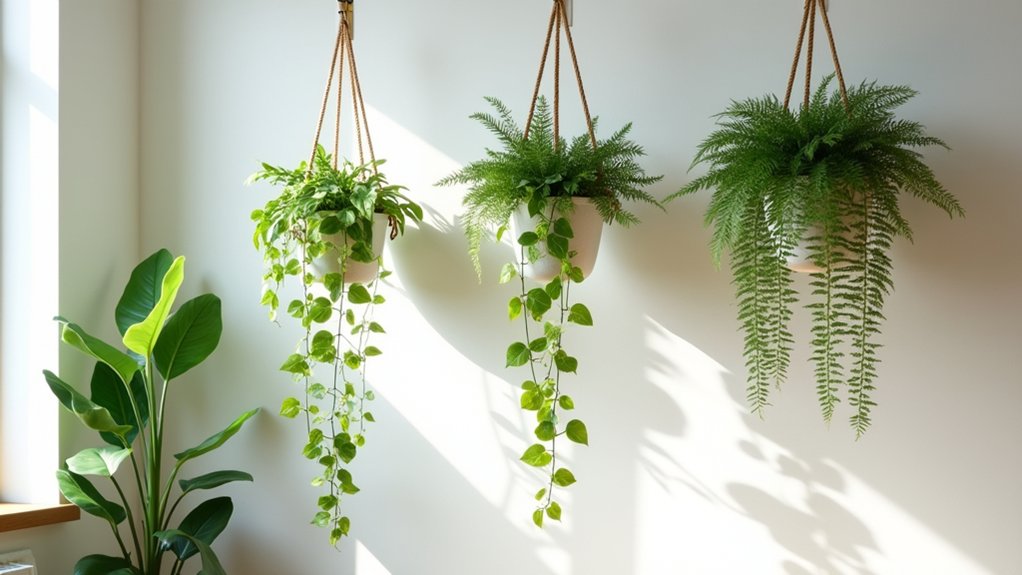
Hanging plants transform indoor spaces by adding depth and visual interest to otherwise unused vertical areas. These suspended gardens can cascade elegantly from ceiling hooks, wall-mounted brackets, or elevated shelves, creating a dynamic interplay of foliage at different heights.
Popular choices like String of Pearls, Pothos, Spider Plants, and Boston Ferns offer varying textures and growth patterns that draw the eye upward while softening architectural lines.
- Light: Most hanging plants prefer bright, indirect sunlight; avoid harsh direct sun that can scorch leaves
- Water: Check soil moisture weekly; water thoroughly when top inch feels dry
- Soil: Well-draining potting mix with added perlite for proper aeration
- Humidity: Moderate to high humidity (50-60%) for optimal growth
- Temperature: Consistent indoor temperatures between 65-80°F (18-27°C)
- Container: Lightweight pots with adequate drainage holes
- Support: Secure mounting systems rated for the weight of plant and container
Regular grooming and rotation ensure hanging plants maintain their appealing form and grow evenly. Trim yellowing or dead foliage promptly to prevent disease spread and encourage fuller growth.
Dust leaves monthly with a damp cloth to maintain photosynthesis efficiency and rotate containers quarterly to prevent plants from growing lopsided as they reach toward light sources.
Check mounting hardware periodically to ensure weight-bearing capacity remains secure as plants mature and increase in size.
Easy-Care Succulents and Cacti
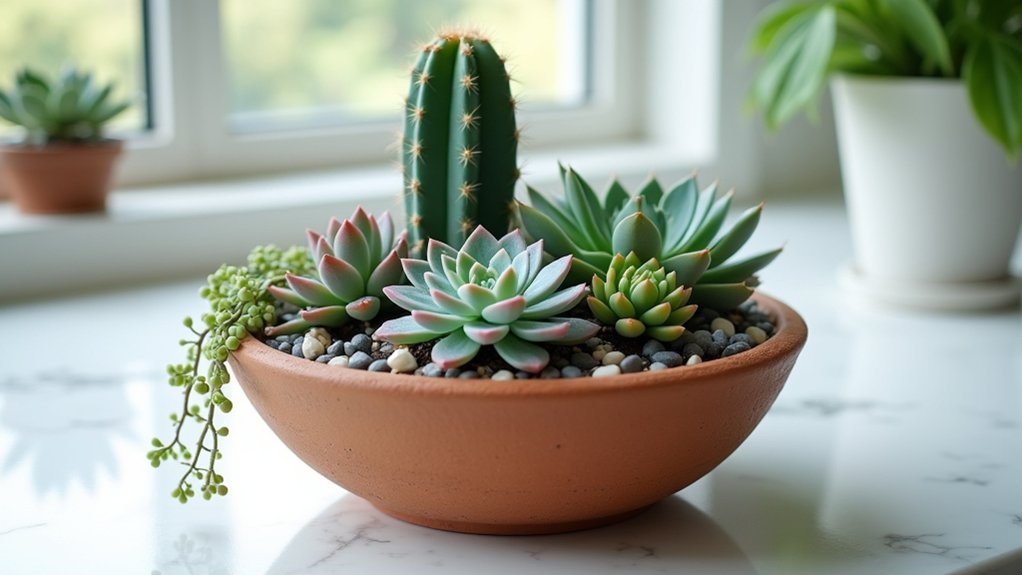
Succulents and cacti are excellent low-maintenance indoor plants characterized by their thick, fleshy leaves or stems that store water.
These desert-adapted plants come in a fascinating variety of shapes, sizes, and colors, from small, compact rosettes to tall, columnar forms, with some featuring striking geometric patterns or unusual textures.
Their distinctive appearance adds architectural interest to any indoor space while requiring minimal care.
- Light: Bright, indirect sunlight; at least 6 hours daily; some varieties tolerate direct sun
- Water: Allow soil to dry completely between waterings; reduce watering in winter
- Soil: Well-draining cactus or succulent mix with added perlite or sand
- Temperature: 60-80°F (15-27°C); can tolerate temperature fluctuations
- Humidity: Low to moderate; adapt well to typical indoor conditions
- Container: Pots with drainage holes to prevent root rot
Proper maintenance of succulents and cacti focuses on preventing common issues rather than frequent care.
Rotate containers quarterly to ensure even growth, and remove any dead leaves promptly to prevent pest problems.
Avoid fertilizing during dormant winter months, and when you do feed during the growing season, use a diluted cactus fertilizer at half strength.
Watch for signs of etiolation (stretching toward light), which indicates insufficient light exposure, and adjust placement accordingly.
Clean dust from leaves occasionally with a soft brush to maintain their natural appearance and ensure optimal photosynthesis.
Tropical Plants for Bathroom Bliss
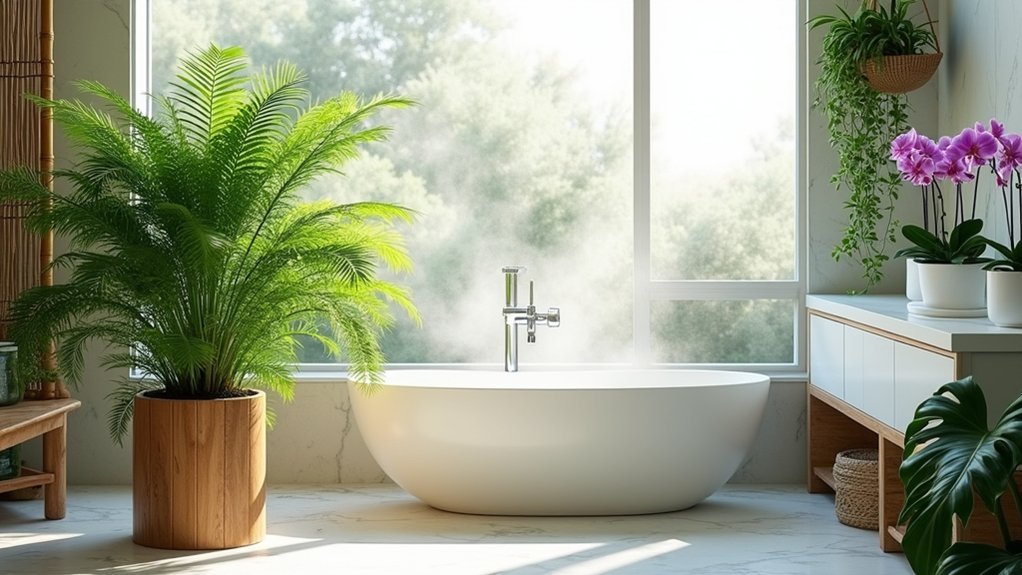
Tropical bathroom plants transform an ordinary bathroom into a lush, spa-like retreat while thriving in the naturally humid environment. These moisture-loving plants typically feature broad, glossy leaves that help purify the air and create a verdant backdrop against bathroom fixtures.
Popular choices include peace lilies, bird’s nest ferns, orchids, and spider plants, which all adapt well to bathroom conditions and contribute to a serene, tropical atmosphere.
- Light: Bright indirect light; can tolerate moderate to low light conditions
- Water: Regular watering when top inch of soil feels dry; benefits from humidity from showers
- Temperature: Warm environment between 65-80°F (18-27°C)
- Soil: Well-draining potting mix rich in organic matter
- Humidity: Minimum 60% humidity; thrives in steamy bathroom conditions
- Container: Pots with adequate drainage holes to prevent root rot
- Spacing: Allow room for air circulation between plants
To maintain healthy tropical bathroom plants, regularly dust leaves with a damp cloth to keep pores clear and maximize their ability to absorb humidity.
Rotate plants quarterly to ensure even growth, and inspect weekly for signs of pests or disease, which can develop in humid conditions. Trim yellowed or damaged leaves promptly, and feed with a balanced, water-soluble fertilizer at half strength during the growing season (spring through fall) to prevent mineral buildup in the humid environment.
Colorful Foliage Plants Beyond Basic Green
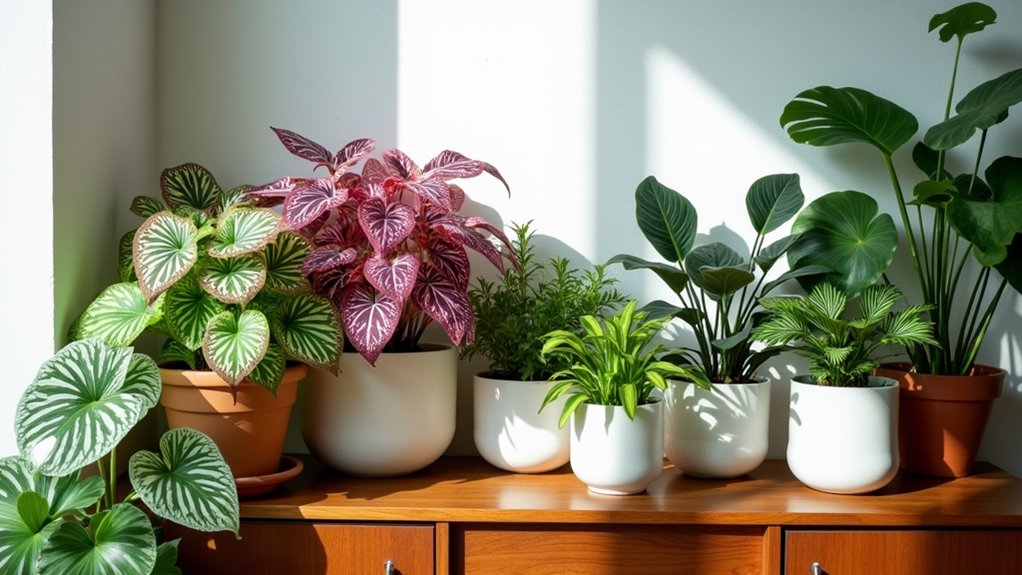
While green may be the dominant color in houseplants, colorful foliage plants offer stunning alternatives with leaves in shades of purple, red, pink, white, silver, and variegated patterns.
These vibrant specimens create dramatic visual interest through their leaf colors alone, without relying on flowers. Popular varieties include Coleus, Persian Shield, Chinese Evergreen, and Calathea, which display bold patterns and rich hues that can serve as living artwork in any indoor space.
Growing Conditions:
- Light: Most colorful foliage plants prefer bright, indirect light; direct sun can fade or burn their vivid colors
- Water: Keep soil consistently moist but not waterlogged; many varieties are sensitive to both over and under-watering
- Humidity: Higher humidity levels (50-60%) support brighter colors and prevent leaf crispy edges
- Temperature: Maintain 65-80°F (18-27°C) for optimal growth
- Soil: Well-draining, rich potting mix with added organic matter
Regular grooming and proper fertilization are essential for maintaining vibrant foliage colors.
Remove any faded or damaged leaves promptly to encourage new growth and prevent disease spread. Feed plants monthly during the growing season with a balanced, water-soluble fertilizer specifically formulated for foliage plants.
Rotate containers quarterly to ensure even growth, and dust leaves regularly to maximize their light-absorbing capacity and maintain their striking appearance.
